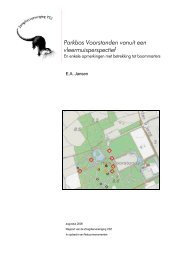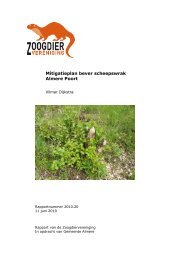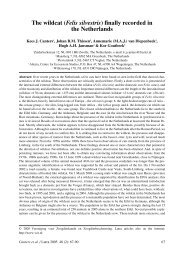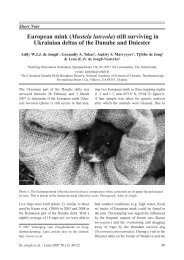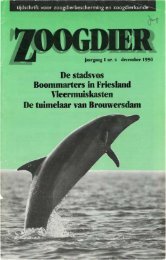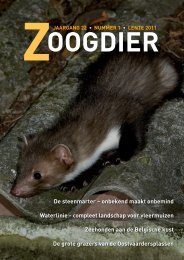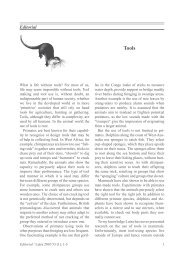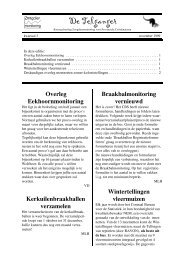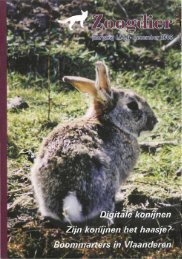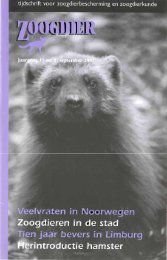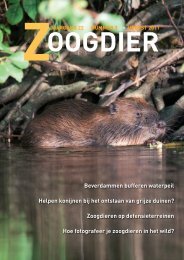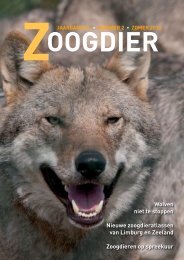De Bechsteins vleermuis en de franjestaart op en rond het landgoed ...
De Bechsteins vleermuis en de franjestaart op en rond het landgoed ...
De Bechsteins vleermuis en de franjestaart op en rond het landgoed ...
You also want an ePaper? Increase the reach of your titles
YUMPU automatically turns print PDFs into web optimized ePapers that Google loves.
English SummaryDuring the past 8 years (from 1999 onwards), the Bechstein’s bat (Myotis bechsteinii)has be<strong>en</strong> found in three differ<strong>en</strong>t hibernacula in rural estates in the province ofOverijssel, the Netherlands. Most of the winters only 1 specim<strong>en</strong> was pres<strong>en</strong>t (with amaximum of 3 bats in the winters of 2001/2002). These findings suggest the pres<strong>en</strong>ceof the species in other seasons as well, since Bechstein’s bats are rarely found in larg<strong>en</strong>umbers in hibernacula in areas with higher d<strong>en</strong>sities. The capture of a femaleBechstein’s bat in September 2003 near the ice house at the Eer<strong>de</strong> estate supports thissuggestion.A study was set up in or<strong>de</strong>r to answer the following questions: 1) is a (viable)p<strong>op</strong>ulation of Bechstein’s bats pres<strong>en</strong>t in the Eer<strong>de</strong> estate or its vicinity; 2) where arepossible summer roosts located, and 3) what habitats do foraging Bechstein’s batsuse? Since a new capture of a Bechstein’s bat, suitable for telemetry, was highlyuncertain, we aimed for a telemetry study of Natterer’s bats (Myotis nattereri) as planb since no reliable information on the hunting behaviour and the foraging habitat ofthis species in the Netherlands was available to date.<strong>De</strong>spite serious efforts, no Bechstein’s bats were captured in the summer of 2004,2005 and 2006. The pres<strong>en</strong>ce of a p<strong>op</strong>ulation in the summer half of the year istherefore uncertain. We suggest that the bats found in and near hibernacula in winterand autumn are most likely vagrants that explore pot<strong>en</strong>tial mating sites andhibernacula. Since Bechstein’s bats are only rec<strong>en</strong>tly hibernating in the area, theestablishm<strong>en</strong>t of a future summer p<strong>op</strong>ulation cannot be exclu<strong>de</strong>d.During the summer of 2005 and 2006, in total 6 Natterer’s bats were radio tracked.All 6 Natterer’s bats predominantly hunted in forest, i.e. both young and oldconiferous, <strong>de</strong>ciduous and mixed forest. None of the bats hunted above or alongsurface water. The hunting behaviour of the tagged bats was thereby highlycomparable to the hunting behaviour that has be<strong>en</strong> <strong>de</strong>scribed from Natterer’s batsfrom surrounding countries.The results of this study will be published in English more ext<strong>en</strong>sively elsewhere.V



